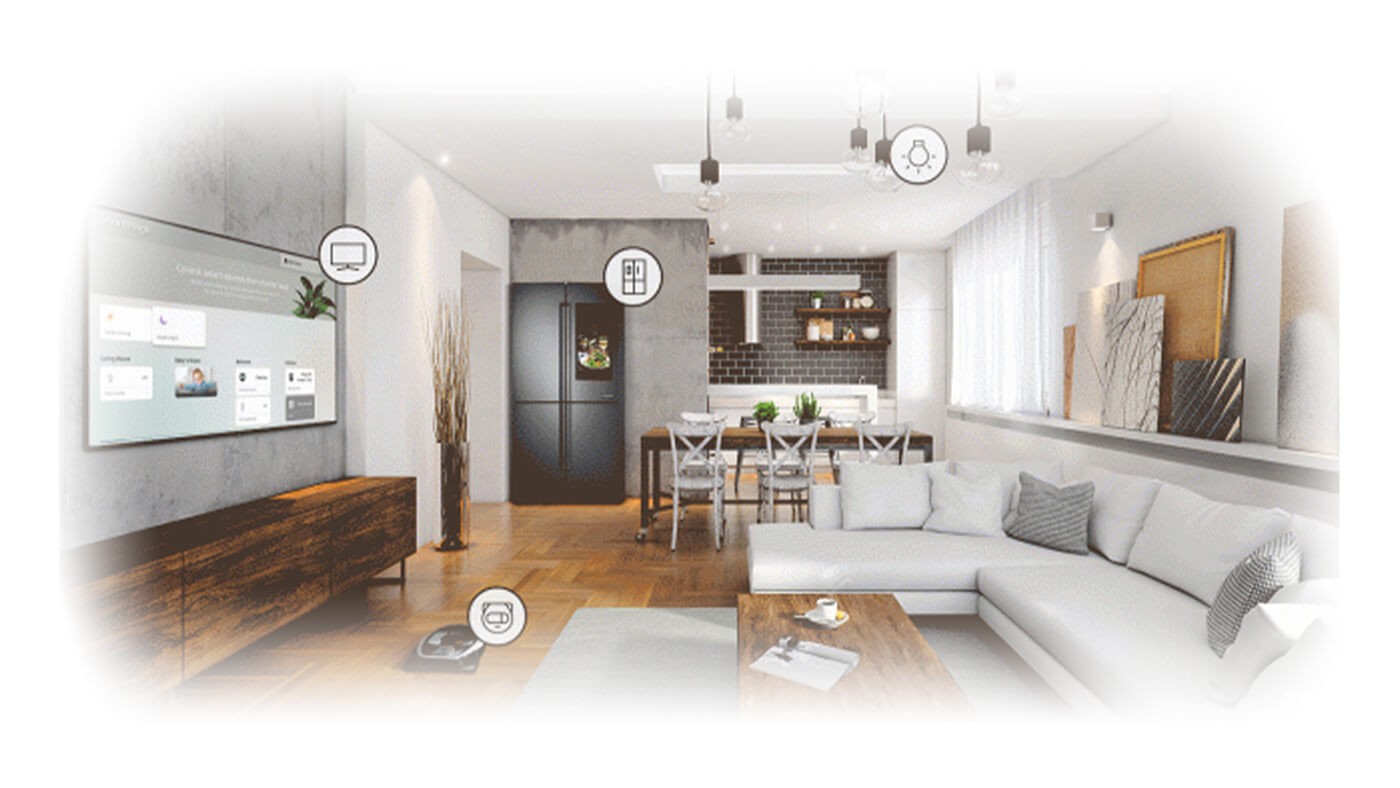- Home
- TVs & Home Theater Equipment Guides
- TV Buying Guide
TV Buying Guide
The role of a television
It goes without saying, that TV’s are essential to the entertainment life within your home. Have you ever walk into a room and it feels like something is missing? I’m sure that feeling sinks in when you walk into a living room, with no TV to pull you into an immersive experience. It’s no secret that whether you use it to watch programs through your cable service, stream your favorite service, or even play video games, TV’s are the superstars of the entertainment scene. For anyone that hasn’t purchased a TV in a while, we will be more than happy to inform you on everything you need to know!
What you should look for when buying a TV

Now that TV prices have dropped, 65” screens have become the norm, while 70” and 80” screens are becoming more affordable. Here at Electronic Express, we carry major brands like Samsung, Sony, LG, TCL, and plenty more! In figuring out how to get the most immersive experience and what TV size would fit perfect for your space, here is a neat trick:
Take the size of the TV screen of your choice and multiply it by two. For example, if you’re choosing a 65” screen TV, then you’ll end up with 130”. 130 inches is the distance you want between you and the 65” TV for the best experience. This also helps in knowing if you have the room for it or not. If you were to choose an 80” screen, that would mean you should sit back 160” away from it to get the best experience. However, If you don’t have enough room to sit back that far, it’d be better to invest in a smaller size. There is a reason why most people don’t like to sit in the front row of a movie theater.
Full HD, 4K, and 8K
Full HD, 4K, and 8K? What does it all mean? We understand when talking about TVs, mentioning topics like 720p, 1080p, 4K, and 8K can seem pretty confusing. We also understand it can get frustrating when all you want to do is watch your favorite content in the best quality possible. Luckily, we can help you understand exactly what all of that means, and why it’s actually important to know in order to find the best quality for you.
When people mentioned 1080p, 4K and 8K, they are referring to the resolution of the screen. The resolution is the number of pixels displayed on the screen that form an image. From the mundane scenes to the action-packed scenes, everything on the screen you’re witnessing on the screen is generated by pixels. So what exactly is a pixel? A pixel is the smallest representative unit of a digital image. When you have hundreds of thousands of pixels together, it creates an image called the resolution.
When you hear a term like 1080p or Full HD, it’s actually in reference to 1920 x 1080 pixels, which is the horizontal and vertical number of pixels on the screen that totals to about 2.1 million pixels in total. 4K resolution holds a 2160 vertical pixel count, up to over a 4,000 horizontal pixel count, and packs four times the total pixels of Full HD (1080p) resolution. 8K resolution holds a 4320 vertical pixel count, up to almost an 8000 horizontal pixel count, packs four times more total pixels than 4K, and 16 times more total pixels than Full HD.
Full HD TVs are at the point where they can fit within just about everyone’s budget, while 4K’s are becoming the new average. 8K is currently the highest resolution defined in the Ultra HD TV standard.
Refresh Rate

It’s not just about the big screen and a pretty picture, but how the image flows is also very important. Ever look at a program on TV, and the image gets choppy when there is fast movement happening on the screen? Well that’s due to the refresh rate. The refresh rate is the number of times a display's image is repainted or refreshed per second. The standard TV will typically contain a refresh rate of 60Hz, while more high-end TVs will contain refresh rates up to 120Hz or higher. If you’re one to watch slow-paced programs then 60Hz should do just fine. However, if you’re an avid sports fan, 120Hz or higher would be the perfect choice.
If you look up above at the picture, it represents watching fast-paced content with lower refresh rate vs. higher refresh rate. On the left, you have a lower refresh rate. What’s happening to the left picture is called motion blur. Motion Blurring occurs because of how your brain processes the set of individual refreshed frames a monitor displays. The brain blurs together the series of frames to create a pragmatic moving picture. However, when you have less frames per second, your brain has to make up more information, thus losing details in the process. With a higher refresh rate, our brain gets to do less work, because it’s given more information to work off of. Because of this, you’ll be able to see the image flow with greater detail.
Popular types of TVs
When it comes to the type of TVs to choose from, LED, OLED, and QLED are your major options. What is LED? An LED, or Light-Emitting Diode, is a semiconductor light source that emits light when an electric current flows through it. In other words, it helps give light and color to the pixels on the screen. LED TVs are the most popular and most readily available.
OLED TVs, O meaning organic, generate on organic light-emitting diodes that triumph over your typical LED when it comes to contrast levels, power consumption, viewing angles, response time and lag. If you’re looking for the deepest black levels, then OLED is the way to go. Organic LEDs have a self-emissive panel so that it can switch individual pixels on and off. By shutting off electricity to pixels in order to create dark areas in the image, it eliminates any sort of light in the area, creating the ultimate contrast.
However, when it comes to pure brilliance, QLEDs are the way to go. QLED, Q meaning Quantum dot, generates incredible brightness with the use of separate backlights, instead of relying on individual pixels to create their own light. You’ll embark on visuals with 100% Color Volume, through images exploding with an array of over one billion shades of vivid and brilliant colors.
Whether you choose a QLED or OLED TV, they both have technologies that advance the way the screen is lit, offering the best color accuracy, brightness, and incredible viewing angles.
Smart TVs

Today, it seems like everyone is on board with getting a smart TV. It’s not surprising that smart TVs are all the rage. Smart TVs are capable of connecting to the internet and act as computers specialized for entertainment. They are also capable of connecting to many other devices, through Bluetooth, Wi-Fi, USB, HDMI, and more! You’ll be able to use these TV’s to download apps, like YouTube, Netflix, Hulu, Disney+, and social media sites like Facebook and Twitter.
There are also smart TV’s that have built-in streaming players, like TCL’s Smart Roku TV. The Roku TV is a smart platform that gives you access to over 500,000 movies and TV shows, through a simple interface. This platform allows you to be able to find content without constantly flipping through input after input. As soon as you turn the smart platform on, all of your favorites will be presented to you.
Some Smart TVs have 4K and 8K AI upscaling processing, smart home features, and even future software update capabilities, so you can get the most out of something that once started out as something to pass the time. That’s right, you’ll be able to take original content and watch it in quality that the creators intended for it, through 4K and 8K AI processing. Smart televisions that contain smart home features are ultimately made to make home life more convenient for you. Samsung’s SmartThings and LG’s ThinQ, which study your habits to give you preventive ideas and recommendations.
With the power of Samsung’s SmartThings, the smart TV will smart devices to an even more effortless tone with a dashboard that has the ability to control your smart home devices and appliances. Whether it’s SmartThing Smart Bulbs, Smart Cams, Smart Hubs, Smart Speakers, you name it, this innovative feature can connect to it all, making home life simple. LG ThinQ®’s AI has very similar features, being able to connect to compatible smart appliances, speakers and many other smart devices. These smart TVs also compatible with Google Assistant and Amazon Alexa, allowing control to the entirety of your home’s compatible devices.
Whether you’re watching sports, movies, shows, or gaming, you’ll enjoy them like never before as you fully engage in an incredible cinematic journey with the endless possibilities for entertainment.